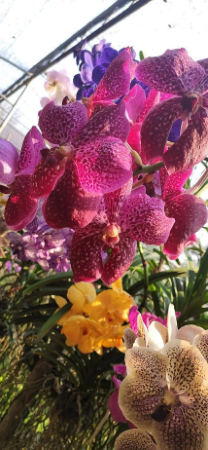 Chiang Mai (Thaïlande) Chiang Mai (Thaïlande)
By dint of seeing elephants everywhere, in statues, paintings, trinkets and even the tags on the walls, we thought that we would be going to see real ones, elephants!
But, beware, there is no question of doing it anyhow.
The subject of elephants is quite sensitive in the region: long exploited and mistreated, they transported tourists, their ass resting on huge structures harnessed on their sensitive back with, always, hooks planted in their ears so that the trainer could steer easily.
Result: multiple injuries, deformities of the spine, pain, unhappiness, animal suffering galore for a few dollars, in short, not cool.
Not cool at all. The associations for the defense of animals got involved, sensitized tourists and tour operators and, today, most of the meetings offered with elephants consist simply of feeding them, bathing them, swimming with them and, sometimes, to mount them "bare back" (which remains controversial).
So we decided to entrust our ethics and morals to the guy from the hotel who had been offering us for a few days a reduced-price excursion "to see the elephants".
The next day a local guide would pick us up and take us, among other things, to visit the huge pachyderms so popular with tourists from northern Thailand.
Here we are the next day, at the back of a boring pick-up, to get to know the two apprentice Barcelona doctors and the French lawyer-prof who will share our day of stroll.
First stop: the "butterfly farm", a butterfly farm intended to recolonize the region.
We wander in greenhouses saturated with the smell of orchids that grow there and, of course, full of multicolored butterflies that fly quietly around us.
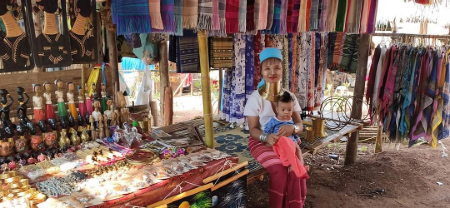 After that, visit the village of Long Neck Karens, a refugee people from the South of China whose women traditionally lengthen their necks using necklaces of golden rings. After that, visit the village of Long Neck Karens, a refugee people from the South of China whose women traditionally lengthen their necks using necklaces of golden rings.
A tradition that is no longer just a pretext to attract visitors and make them buy local products.
Then comes the time to meet the elephants.
We arrive in what appears to be a small family farm; dogs, chickens and chicks run freely between our legs, the elephants are at the other end of their enclosure, open on the road and river sides.
Like all domestic animals on earth, when the farmer brings the basket of food, the two elephants rush towards us.
We will then spend a good half hour giving them pieces of sugar cane, which they delicately catch from the tips of the trunk and stuff into their mouths in packs of three or four.
The trainers then suggest that we "wash the elephants".
This is where we see some "details" that the fence hid from us before: handcuffs and short chain on the front paw, many scars on the ears probably due to the training hooks, cut tusks, seeing the animals more close we guess that they have not always been treated well.
To lead them to the river so that they can be bathed, the farmers pull their ears and whip them with a small flexible stick.
We do not guess any affection between humans and animals.
These do not even have a name.
I will be the only one to enter the river but, given the reluctance of the elephants to stay there, I will quickly give up. No need to encourage trainers to use their coercive means to force the critters to bathe when they don't want to.
Mixed result, therefore, for this "ethical" meeting ...
Small family farms that have invested in elephants, there are dozens in the Chiang Mai area.
The animals are recovered from old organizations offering walks on their backs (which is now prohibited) or completely uprooted from the wild.
How to train and treat them depends on the goodwill of the humans who care for them ...
And even if the humans in question no longer ride on their backs, they remain animals in captivity, bred and living on the hook of men, difficult for them to return to a natural environment, especially since there are no longer many places where they can live in peace and security ... Mouais.
We will end the day with a two hour hike in the jungle, destination: a magnificent waterfall hidden by lush vegetation.
So much for the Chiang Mai elephants.
Regrets to have paid and therefore guaranteed this without knowing what awaited us.
Doi Inthanon, Chiang Rai et Triangle d'Or (Thaïlande)
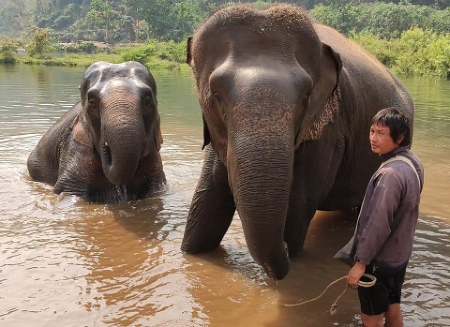 Our out of town getaways start with Doi Inthanon National Park. Our out of town getaways start with Doi Inthanon National Park.
Formerly Doi Luang, or "King's Mountain", the highest peak in Thailand - proudly culminating at 2565 meters - was renamed in honor of the last king Lanna of Chiang Mai, Intha Witchayanon (yeah, they had the good idea of shortening in "Inthanon").
He liked this mountain so much that he asked that his ashes be spread there.
They were transferred there in 1897, not far from the top of the mountain.
Today there is a memorial in his honor.
You should know that the province of Chang Mai, formerly inhabited by the Lanna people, remained independent for a long time.
Older than Siam (then known in present-day Thailand), the Lanna kingdom, founded in 1259 by King Mengrai, was a set of more or less autonomous city-states.
They were annexed to Thailand in 1892.
We will see the difference between the modest memorial to Intha Witchayanon, lost in the mountain vegetation and the very golden and very kitsch "chedi", mausoleums built not far from the highest peak, in honor of the king and queen of Thailand ... spa the same culture.
Doi Inthanon is the only place in Thailand where the temperature can drop below freezing.
As soon as it snows, the Thais rush to see this rare white coat cover the region.
Thermal shock when you know that a few kilometers lower, it is 35 degrees all year round.
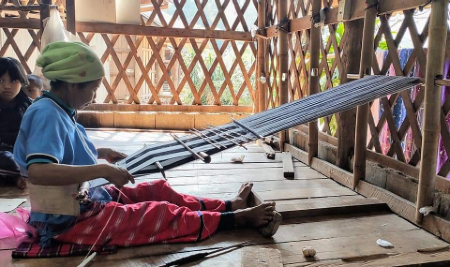 It is also the beginning of the area where the poppy intended for the manufacture of opium and heroin was cultivated without complex: the famous golden triangle. It is also the beginning of the area where the poppy intended for the manufacture of opium and heroin was cultivated without complex: the famous golden triangle.
Today, the government is struggling to rehabilitate the crops and provides farmers with subsidies and training to replace the poppy with arabica coffee.
There is even a kind of coffee, a little like the African Kopi Luak, whose treatment consists in being digested (and shit) by the elephants.
Otherwise, more conventionally, say, the red-skinned coffee beans are first peeled, then dried in the sun before being soaked in water until germination and then dried again in the sun until completely black. .
Among these farmers, many Karen tribes, refugees from southern China or Myanmar.
We will meet the White Karens, established for over a century in what is now Doi Inthanon National Park.
Their name comes from the tradition of, for unmarried women, wearing a white cotton tunic.
From the age of 9, the women of this tribe learned the ancestral art of weaving.
The result is magnificent fabrics and clothing in a thousand colors (except for single girls of course). Three weeks for a scarf, three months for a bed cover, it took time and patience.
Right now, both girls and boys go to school, tribal men work as wardens for the national park, women grow some coffee, and only grandmas know. weave.
We will be surprised to find chapels and crucifixes in these villages at the bottom of the Thai mountains.
Catholic missionaries have been there: 70% of Karens are therefore Christians ... The rest are Buddhists, an opportunity for them to send their sons to the monasteries where they will be educated, housed, fed, laundered: one less charge for the tribe.
Speaking of monks, do you know how to distinguish those who live in the city from those who live in the countryside?
At their overweight.
The former are stuffed with offerings while those who live in more remote monasteries must use the surrounding nature to find their food: gathering or cultivation.
Then visit the Golden Triangle, a small triangular island in the middle of the Mekong River not belonging to any of the three countries whose borders cross here (Thailand, Laos and Myanmar), where opium traffickers met their customers to exchange their opium production for gold, which is more attractive than local currencies.
Passage to Chiang Rai, finally, where we visit the magnificent white temple, the blue temple where everything is painted in shades of blue, green and purple and the "black house", a museum bringing together the very gothic creations of the artist today. now deceased Thawan Duchanee.
Vouli voilou, look at the photos for the temples of Chiang Rai, it's worth it
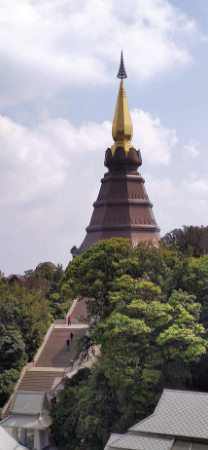
Pai (Thaïlande)
Here we are leaving Chiang Mai in a vaguely air-conditioned mini-van jumping on the mountain roads. Three hours of turning at the head of a pin, between cliffs and precipices, to bypass the intrepid motorcycles, overtake the trucks of too slow farmers and stop to let cross herds of lean dairy cows.
Destination: Pai. A city where the hippies of the 70s got stuck and which attracts all modern backpackers.
Tattoo parlors, bars, parties, circus, street art, fire shows, it feels more like being in a psytrance festival than in a small Thai town.
The crossed faces are almost exclusively white and the Westerners installed here hold shops, hotels, bars and tattoo parlors.
We speak English, German, French as much as Thai.
On the road to Pai, the mini-van is suddenly stopped by a barrage of soldiers.
"Nobody moves!" are we barking in aggressive English while one of the soldiers gets on the bus to check ... our temperature.
With his mask, gloves and thermometer of the future, he is in fact an employee of the Ministry of Health, as attested by the caduceus badge on his uniform.
Paranoia, paranoia ...
Fortunately no one is sick, we might all have ended up in preventive quarantine.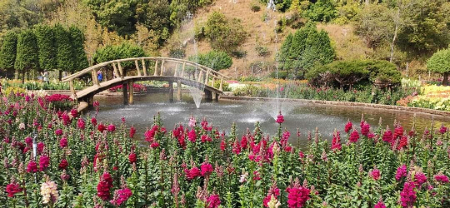
Around Pai nature is just beautiful and amazing.
First of all, the caves, which we visit with a guide carrying an oil lamp.
To go from one zone to another, we take the river, sitting cross-legged on bamboo rafts that the guide leads using a long pole.
In the 50 cm of water swim hundreds of large black fish and the caves that we cross echo the cries of thousands of bats hanging from the ceiling.
After the caves, passage to the hot springs.
We enter it as in a bath and, despite the 30 degrees in the shade, we would be almost cold when leaving.
There is also the "bamboo bridge", a 1km long bamboo bridge which crosses a swamp to bring us to a temple where "women" are "not allow" (in English in the text, fault included) .
What is this sexism again ?!
We are the only ones who have to cover our knees and shoulders at each "sacred place" (and there are a lot of them in Thailand, sacred places) ...
Like a guy's knee and shoulder, it's not sexy, but with girls, oulaaaah, that might take Buddha out of his nirvana.
Speaking of temples, we pay a short visit to the White Buddha, a giant statue installed in the heights that can be seen almost everyw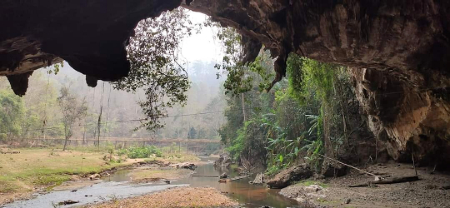 here in the city. here in the city.
To have the right to climb near the giant Buddha, you must dress chastely!
Fortunately, for impure and improvident females, monks rent suitable outfits - each more horrible than the other - for a few cents. It is the first and last time in my life that I wear a burgundy diamond skirt with a canary yellow scarf with large pink flowers.
Today my sense of aesthetics has been irreparably hurt.
Another tradition not to be missed when you visit Pai is to go and admire the sunset from the winding paths at the top of the cliffs of the Canyon.
Red earth, black and scarlet striated rock, trees that lose their big red leaves like an Indian summer, arid landscapes ... It's just hot!
We go up there at the end of the afternoon.
Sitting facing west, legs hanging in the void, the sun is nothing more than a red ball which disappears on the horizon around 6:20 pm (and after that it starts to get dark! This is why the Thais go to bed early and get up early at 6:30 p.m. it is night).
Back 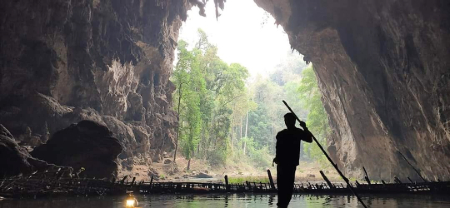 in town, the night market is a nightmare for bulimics in remission. in town, the night market is a nightmare for bulimics in remission.
Too many good things to eat everywhere: donuts of all kinds, gyozas, noodles, pad thai, falafels, soups, pancakes, mini pancakes, fresh fruit, mangoes with sticky rice, ...
It is impossible to taste everything without gaining ten thousand kilos.
Quiet festive atmosphere, in the bars of the city it's "happy hour" all evening, we stop there to drink mojitos and play board games on the tables.
Finally, rest at our "hostel" where we rent for 8 € a night a straw bungalow in what looks more like a hippie camp than an inn: campfire all evening, techno music and psytrance, tags to fluorescent paint on the walls ...
We stay in the theme of Pai say.
Voili voilou for our two days in this small town in the north of Thailand, refuge of alternative dreamers, which seems anchored all year round somewhere out of reality.
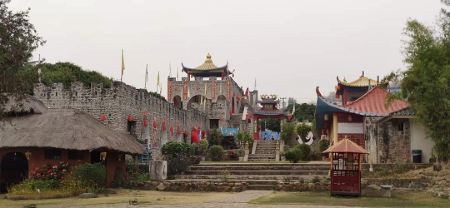
|
 Chiang Mai (Thaïlande)
Chiang Mai (Thaïlande) After that, visit the village of Long Neck Karens, a refugee people from the South of China whose women traditionally lengthen their necks using necklaces of golden rings.
After that, visit the village of Long Neck Karens, a refugee people from the South of China whose women traditionally lengthen their necks using necklaces of golden rings. Our out of town getaways start with Doi Inthanon National Park.
Our out of town getaways start with Doi Inthanon National Park. It is also the beginning of the area where the poppy intended for the manufacture of opium and heroin was cultivated without complex: the famous golden triangle.
It is also the beginning of the area where the poppy intended for the manufacture of opium and heroin was cultivated without complex: the famous golden triangle.

 here in the city.
here in the city. in town, the night market is a nightmare for bulimics in remission.
in town, the night market is a nightmare for bulimics in remission.